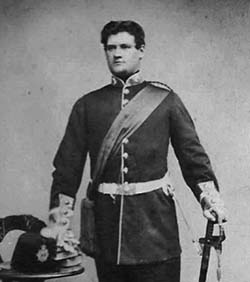Arthur PHELPS 1837 - 1920
Tenth child and fourth son of Joseph PHELPS (1791–1876) and Elizabeth DICKINSON (1795 – 1876)
Born 24th October 1837, Funchal, Madeira
Died 4th October 1920, Birmingham. Cremated at Perry Barr but commemorated on a stone in Witton Cemetery.
Married 19 February 1868 in St Thomas Cathedral, Bombay, to his second cousin Caroline Ann PEYTON (1833 – 1904)
Children
1) Malet Peyton PHELPS (1869–1950) m. Dorothy Heath SMITH 1883 - 1951
2) Murray Newton PHELPS (1871–1948) m. Ethel May KITSON 1874 - 1945
3) Elsie Lora PHELPS (1872–1951) m. Charles Holt CALDICOTT 1871 - ???
4) George Ingram de Brissac PHELPS (1875–1938) m. Evangeline Josephine FENTON 1881 - 1958
From 'A Shoebox of Letters'
As a young child growing up in Madeira, Arthur learnt to speak Portuguese, but quite formal schooling by older sisters began early. He would have learnt reading, writing and arithmetic and we read of his struggles with a Latin primer, helped by his sister Harriet.
Aged 9, Arthur was taken to Market Bosworth in Leicestershire where he lived in the home of his mother's sister Anne, who had married Dr Arthur Benoni EVANS. He attended the school of which his uncle was headmaster, where his older brothers had gone before him. He spent holidays with his grandmother and aunt at Bramblebury in Woolwich, or with cousins. The year of 1853 was spent at Dr Bridgman's academy in Woolwich, preparing for the entrance examinations for the British East India Company's armies.
In January 1854, aged 16, Arthur was posted to the 11th Bombay Native Infantry, and two years later qualified as a surveyor. He entered the Poonah Military College in order to qualify as a civil engineer. He learnt to speak both Mahrati and Hindustani fluently. In 1858 Arthur entered the Commissariat and Transport Department and was put in charge of the Jaulna Field Force. After a year’s service he returned to Bombay and then joined the Kattiwar Field Force.
In 1866 he took leave having attained the rank of Colonel and spent some of this time with his sister and brother-in-law, Harriet and John Crompton in Natal. Afterwards Arthur went on to England, where his parents were then living. He would have renewed contact with Caroline Peyton as well as other relatives.
Returning to India, he saw service in many military stations of the Bombay Presidency, including Aden, where his first two children were born. During the Second Afghan War he was in charge of the commissariat and in 1880 was made Commissary-General. He was elevated to Major-General in 1888, and Lieutenant-General in 1893. Arthur also helped to set up a homeopathic dispensary during his time in Bombay. In 1894 he and Carrie travelled extensively in India and Ceylon.
Finally settling back in England, Arthur took great interest in many subjects such as architecture, archaeology, bimetallism, and the occult. He was a vegetarian and fought to ban vivisection. He became a Unitarian having broken away from the high church leanings of the rest of his family, though sharing their love of music which played a large part in his and Caroline’s lives.
Arthur was a leading supporter and spokesman of the National Anti-Vaccination League and in 1897 was elected President. (At this time, there was good reason to question the wisdom of vaccination, particularly the way in which the vaccines were prepared which could lead to other infections being transmitted to the patient.)
After his wife's death in 1904, Lucy Phelps a younger cousin of both Arthur and Carrie, came to keep house for him at Woodbourne Grange, 23 Augustus Road, Edgbaston, where he often had his grandchildren to stay. Abel (son of Malet) and Sheila (daughter of George) spent most of the years of WW1 with Arthur while their fathers were involved in war duties. Abel remembered sitting on his grandfather's lap and running his fingers through Arthur's long, silky beard.
In 1920, Arthur died at home a few weeks before his 83rd birthday, and was cremated at Perry Barr, having been a staunch advocate for cremation.
Letters received and preserved by Arthur during his time in England and India, form the major part of ‘A Shoebox of Letters’ by Penelope Forrest, Anthea Boylston and Judith Frances Hubbard, published in 2016.
Summary
A lifelong friend of my great grandmother Emma.
Judith Frances Hubbard

